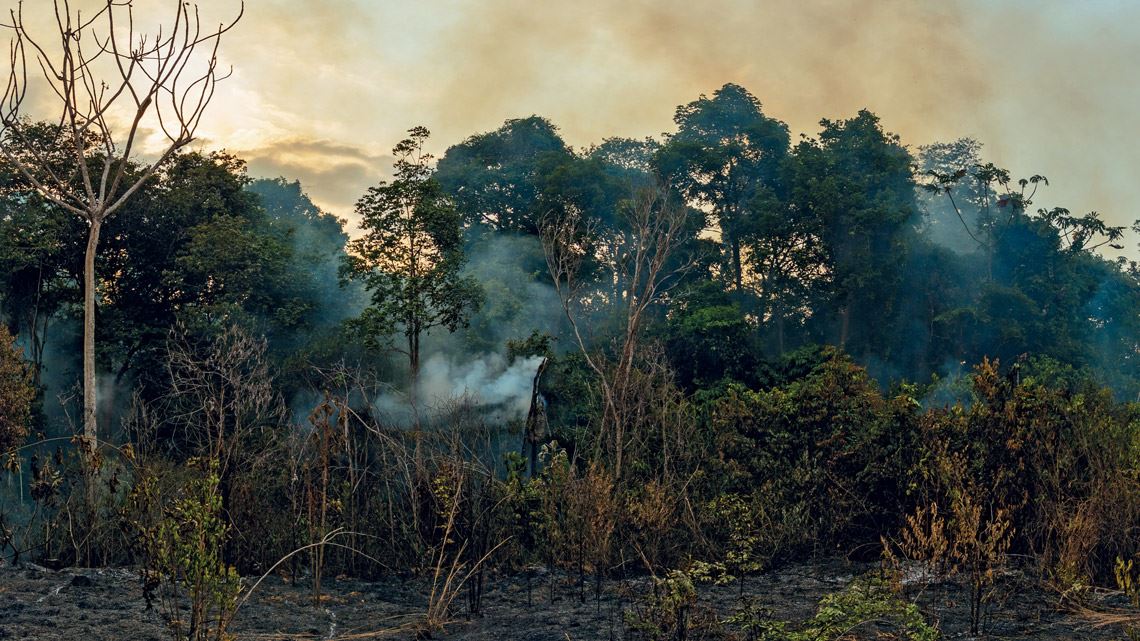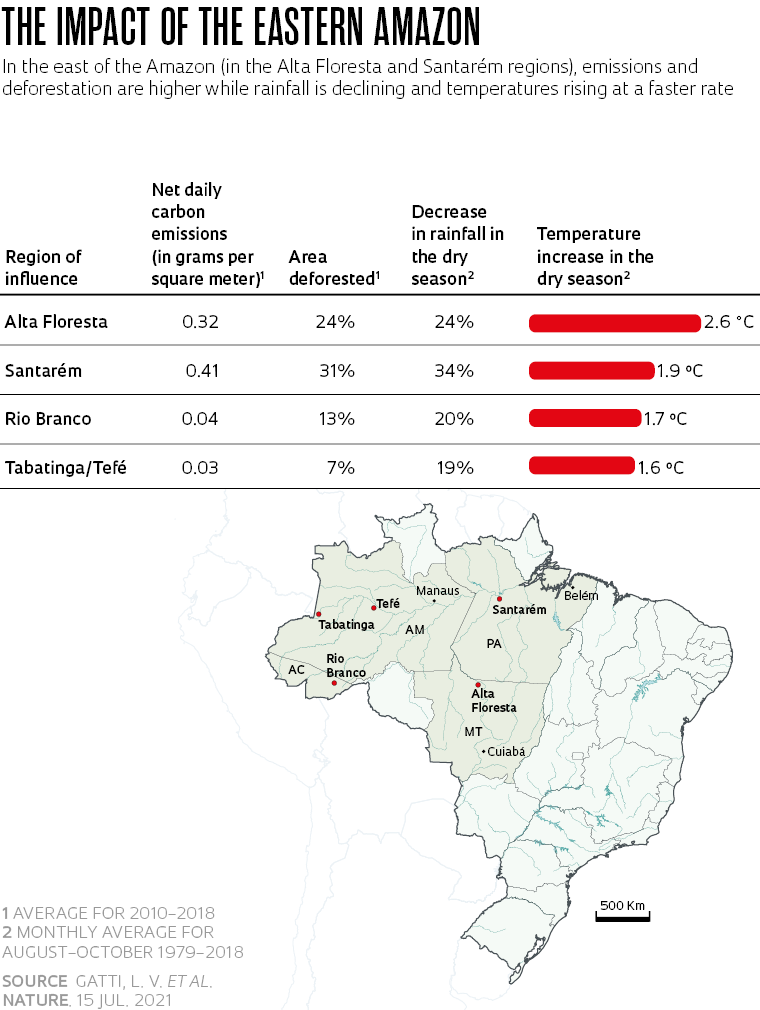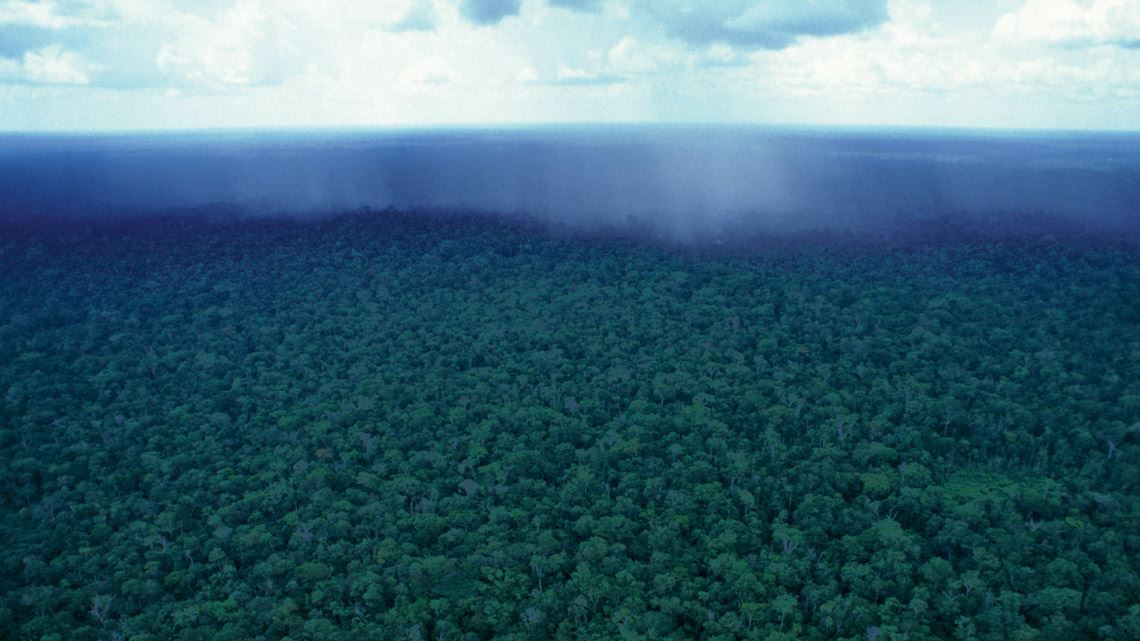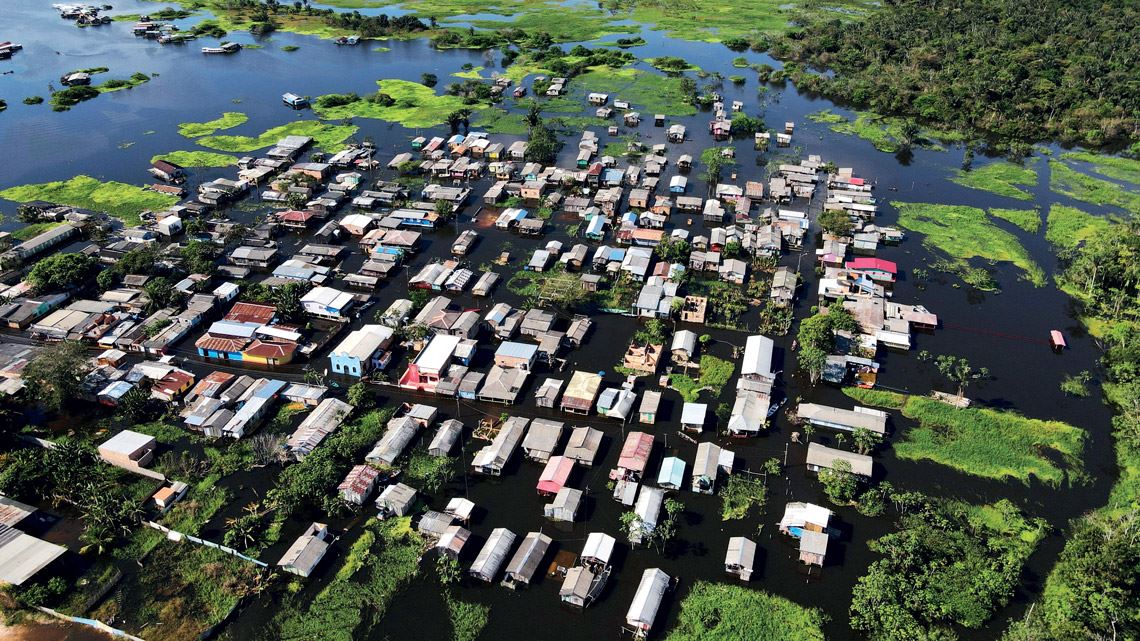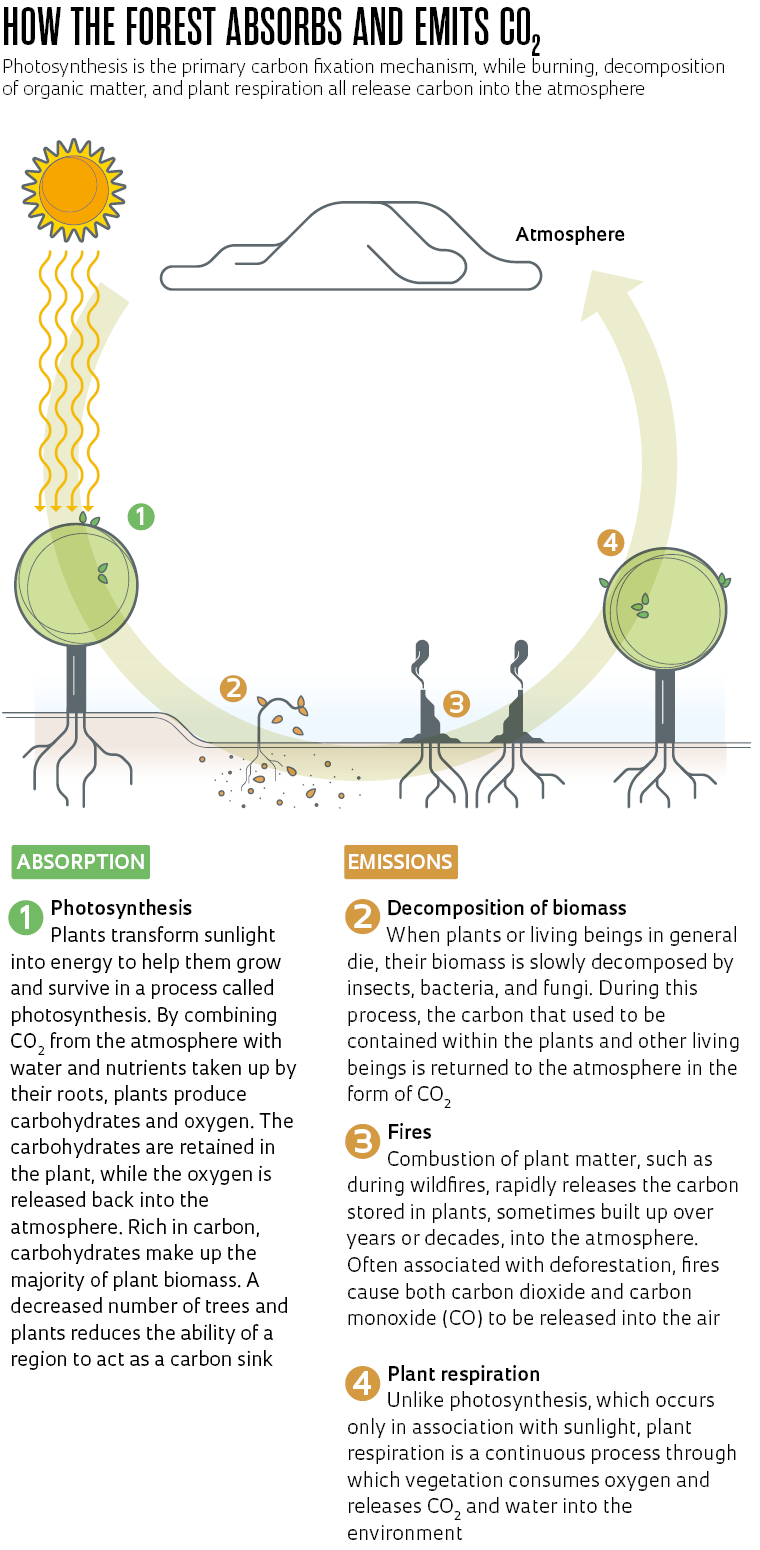The latest report from the Global Carbon Project report, published last December, estimates that since the 1960s, terrestrial plants have removed about 25% of carbon dioxide (CO2)—a greenhouse gas that is emitted by burning fossil fuels and contributes to global warming—from the Earth’s atmosphere. This beneficial effect occurs because the rate at which plants photosynthesize, a process that involves consuming CO2 from the air to stay alive and grow, is slightly greater than the rate at which carbon dioxide is emitted by burning biomass, decomposing organic material, and plant respiration. The difference between absorption and emission is small, at around 2%, but it is enough to classify forests, especially dense and lush rainforests, as important carbon sinks—the term used for areas where carbon absorption exceeds emission.
As the largest tropical forest on Earth, maintaining roughly 80% of its original area, the Amazon is considered one of the world’s most important carbon sinks. However, studies carried out over the last 10 years using a variety of analytical methodologies, including satellite data, tree growth and mortality records, and systematic sampling of the air above the forest, suggest the eastern Amazon has become a carbon source in the past decade, meaning the amount of CO2 emitted in the region surpassed the amount absorbed. The situation is particularly worrying in the southeast of the biome in the states of Pará and Mato Grosso, an area known as the Arc of Deforestation, where the majority of human activity is concentrated. The latest research to reach this conclusion is a long-term study led by chemist Luciana Vanni Gatti, from the Brazilian National Institute for Space Research (INPE), the main results of which were described in an article published in the journal Nature in mid-July.
After taking precise measurements of carbon levels in air samples from four regions of the Amazon between 2010 and 2018, the study found that average CO2 emissions were about 10 times higher in the east of the rainforest than in the west during the period. “We observed that parts of the forest that have lost more than 30% of their area to deforestation emitted much more carbon than those where the deforestation rate was below 20%,” says Gatti, who studies the chemistry of the Amazon’s atmosphere in a project that is part of the FAPESP Research Program on Global Climate Change (see table above). “Meteorological data show that in the last 40 years, the eastern Amazon experienced the greatest average temperature increase and the greatest reduction in rainfall during the region’s dry season between August and October.”
Despite the west of the biome being wetter and better preserved, it’s carbon balance (the sum of all emissions and absorption) is still delicate. Its transition from a carbon sink to a carbon source appears inevitable, although for now the process is in the early stages. “If the west of the Amazon suffers further impacts of human activity, it is possible that it will follow the same pattern that we are seeing in the east,” chemist John Miller, from the USA’s National Oceanic and Atmospheric Administration (NOAA) and one of the article’s authors, said in an interview with Pesquisa FAPESP.
In the east of the rainforest, the average temperature in the dry period has risen by more than 2 degrees Celsius (˚C) while rainfall has fallen by at least 25% over the past four decades, according to calculations made by Gatti’s team. The dry season has also become longer, with a greater number of days without significant rainfall. In western Amazonia, the average temperature increased and rainfall declined between 1979 and 2018, but at a slower pace. The temperature increased by 1.7 ºC at most, and the average rainfall fell by 20%, according to the article. In the Amazon, a month is considered dry if it experiences less than 100 millimeters (mm) of rainfall.
It is not only deforestation and wildfires that directly affect the carbon balance. Areas of degraded forest, despite still standing, become drier and start to emit more CO2 than they absorb. “We are facing a perfect storm, a vicious cycle in which one process feeds back into the other,” says INPE ecologist Luiz Aragão, a specialist in remote sensing and coauthor of the article. “The rise in deforestation, wildfires, and degradation increases carbon emissions in the Amazon, altering the local and global climate. The rainforest is becoming warmer and drier, especially during the dry season, and tree mortality is increasing. This itself affects the carbon balance and causes further climate change.”
Physicist Paulo Artaxo of the University of São Paulo (USP) highlights the importance of the findings of his colleagues’ paper in Nature. “Changes in the Amazon’s carbon cycle have climate impacts not only in the region, but across the whole of Brazil and even worldwide,” points out Artaxo, one of the coordinators of the FAPESP Research Program on Global Climate Change (PFPMCG). Some of the moisture in northern Brazil is transported to the midwest, southeast, and other parts of the country by what are known as flying rivers. Without these atmospheric channels of water vapor, rainfall patterns change in these regions and severe droughts can occur. Aragão, head of the INPE’s Earth Observation and Geoinformatics Division (DIOTG), has been studying the long-term impacts of deforestation and fires in particular—two human-driven forms of aggression against the rainforest—in areas of the Amazon where the vegetation has been degraded. He is also one of the coauthors of another paper, published in the journal PNAS in July, which describes the effects of the El Niño weather phenomenon (associated with unusually warm surface waters in the Pacific Ocean) on the great drought suffered in the Amazon between the end of 2015 and the beginning of 2016.
According to the article, whose main author is Brazilian biologist Erika Berenguer, from the University of Lancaster in the UK, roughly 3 billion trees died in an area equivalent to 1.2% of the Brazilian Amazon over the following three years due to the extreme drought and forest fires. One of the impacts of this abnormally high level of tree mortality is that tons more carbon is released into the atmosphere. “Recent studies indicate that wildfires associated with deforestation are more intense than other types of fire in the Amazon and lead to higher carbon emissions,” explains climatologist Renata Libonati, head of the Laboratory for Environmental Satellite Applications at the Institute of Geosciences (IGEO) of the Federal University of Rio de Janeiro (UFRJ), who did not participate in the study.
July’s Nature paper is the continuation of a research project led by Gatti, which resulted in a feature article published in the scientific journal in 2014. The first study used the same data collection methodology adopted in the current research but covered a period of just two years: 2010 and 2011. The new article added another seven years of field data. “In the 2014 study, we showed that an extremely dry year like 2010 led to the Amazon emitting more carbon than in a year with the expected climate, such as 2011,” explains biologist Luana Basso, a member of Gatti’s team who is currently doing a postdoctoral fellowship at the University of Leeds, UK. “The focus back then was on time as a variable. Now, our emphasis is on showing how the carbon balance differs in areas of the Amazon experiencing varying levels of deforestation, fires, and climate change.”
The data behind the most recent paper was gathered through extensive fieldwork. Using a small plane flying at altitudes of between 300 meters and 4.4 kilometers, the researchers collected air samples from four locations in the Amazon every two months: Alta Floresta in Mato Grosso, in the southeast of the rainforest; Santarém in Pará, in the northeast; Rio Branco in Acre, in the southwest; and Tabatinga in Amazonas, in the northwest. In some years, the northwestern samples were actually taken in Tefé, but for practical purposes, the data from Tefé and Tabatinga are considered representative of the same region. In total, 590 atmospheric samples were collected.
The authors of the article highlight advancing deforestation and fires in the eastern Amazon as the main factors behind the region becoming a carbon source. With fewer trees, the ability to remove CO2 from the atmosphere via photosynthesis decreases (see sidebar on forest carbon cycle). If the vegetation is burned in addition to being cut down, the carbon stored in the plant’s biomass is returned directly to the air. The authors say that if there were no deforestation or fires, the Amazon as a whole would function as a carbon sink. However, their data suggest that the southeast—the region most impacted by humans—already acts as a carbon source even when disregarding the contribution of emissions specifically from fires.
“The longest-living tree species in the Amazon can live for an average of 180 years,” points out botanist Marcos Buckeridge, from USP’s Institute of Biosciences, who studies the growth of plants and crops in environments rich in carbon dioxide and did not participate in the study led by Gatti. “Most of the carbon absorbed by the plants is stored in them for this entire time and is only released when they die. The carbon is slowly released as they decompose, while burning releases it at a much faster rate. As soon as plants begin to regrow in a deforested area, carbon starts being absorbed again.”
Other studies reached similar conclusions to those conducted by Gatti, Aragão, and their colleagues. An article published in Nature Climate Change in April this year found that the Amazon emitted 18% more carbon than it absorbed between 2010 and 2018. The carbon balance was calculated from CO2 flow measurements taken by satellites. The study estimated that areas where vegetation has been degraded, which are usually near deforested areas and farms or ranches, emitted significant amounts of carbon compared to fully deforested areas. “The Brazilian Amazon as a whole has lost some of its biomass, and therefore released carbon. We all know the importance of Amazon deforestation for global climate change,” Stephen Sitch, from the University of Exeter, UK, one of the authors of the paper, said in a press release. “Yet our study shows how emissions from associated forest degradation processes can be even larger. Degradation is a pervasive threat to future forest integrity and requires urgent research attention.”
A Nature article from 2015 is a mandatory reference on the subject of the carbon balance of the world’s largest rainforest. Led by researchers from the University of Leeds with the participation of colleagues from Brazil and other countries, the study suggested that the Amazon has been progressively losing its ability to remove carbon from the atmosphere due to an increase in tree mortality of more than a third since the mid-1990s. As well as deforestation and degradation, climate change is driving this phenomenon both locally and globally. The field study monitored biomass changes (increases and decreases in tree size) in 321 forest parcels over three decades.
Climatologist José Marengo, head of research and development at Brazil’s National Center for Natural Disaster Monitoring (CEMADEN), praises the study for its important contribution to science. “Several studies indicate that the east of the Amazon really is becoming a carbon source, while other research, including ours, shows that the dry period in the region has been getting hotter and drier in recent decades,” says Marengo. “This is not good for the carbon balance and increases the risk of droughts and fires.” But the Amazon is very large and making generalizations for the entire region is risky. Some climate models, for example, predict that it could rain even more in some northwestern areas of the Amazon over the coming decades due to global climate change. The west, which is better preserved, is also currently wetter than the east, recording rainfall of more than 3,000 mm per year.
Global warming is the most visible element of climate change, but that does not mean that everywhere will always get hotter. Certain places may even get cooler at certain times of the year. The planet’s average temperature will rise rapidly in the coming decades, however, due to the increased emission of greenhouse gases, mainly as a result of burning fossil fuels. “People have to keep in mind that global warming induces climate changes and leads to more frequent extreme weather events, such as intense droughts or periods of rain, heat, or cold,” says Marengo. In this global context, although the Amazon is becoming hotter and drier (and emitting more carbon) both locally in the east and as a whole, it is not paradoxical that the Negro River in Manaus experienced the largest flood in nearly 120 years at the end of June this year. Due to heavy rains, the river level rose by 30 meters, affecting the lives of almost half a million people in the state. At around the same time, another anomaly attributed to climate change by scientists occurred in Canada and western USA this summer, when thermometers registered record temperatures of above 50 °C. In July, Germany, Belgium, and the Netherlands all saw their worst floods in a century, also credited to climate change by some.
Climatologist Scott Denning of Colorado State University, USA, believes the results of the Brazilian study published in Nature raise doubts over the Amazon rainforest’s long-term ability to remove carbon from the atmosphere and continue serving as an important counterbalance to global warming. “The continuous monitoring of four regions across Amazonia by this team provides a type of data that is very difficult to obtain and shows that the Amazon’s status as a carbon sink is under threat from forest degradation and warming,” Denning, who wrote a commentary in Nature on the INPE group’s article, told Pesquisa FAPESP in an interview. “The future of carbon accumulation in tropical forests has long been uncertain. Gatti and colleagues’ atmospheric profiles show that the uncertain future is happening now.”
Project
Interannual variation of Amazon Basin greenhouse gas balances and their controls in a warming and increasingly variable climate – CARBAM: the Amazon carbon balance long-term study (nº 16/02018-2); Grant Mechanism Thematic Project; Global Climate Change Research Program; Principal Investigator Luciana Gatti (INPE); Investment R$4,436,420.43
Scientific articles
GATTI, L. V. et al. Amazonia as a carbon source linked to deforestation and climate change. Nature. July 15, 2021.
BERENGUER, E. et al. Tracking the impacts of El Niño drought and fire in human-modified Amazonian forests. PNAS. July 27, 2021.
Republish